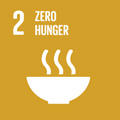- Docente: Riccardo Baroncelli
- Credits: 6
- SSD: AGR/12
- Language: Italian
- Moduli: Riccardo Baroncelli (Modulo Mod 1) Laura Depalo (Modulo Mod 2)
- Teaching Mode: Traditional lectures (Modulo Mod 1) Traditional lectures (Modulo Mod 2)
- Campus: Cesena
- Corso: First cycle degree programme (L) in Food Technology (cod. 8528)
-
from Sep 17, 2024 to Dec 16, 2024
-
from Oct 14, 2024 to Nov 12, 2024
Learning outcomes
At the end of the course the student will be able to make a diagnosis of the main postharvest diseases and disorders, and of the alterations induced by insects in stored plant products. He will be able to evaluate also their influence on processed plant products.
Course contents
The course is divided in two didactic units:
- Postaharvest pathology of plant foodstuff (4 CFU)
- Entomology of plant food stuff (2CFU)
Pathology of Products and Stored Goods (4 ECTS)
Teaching Units
General Section (6 hours)
• Importance of diseases (biotic and abiotic) as a cause of post-harvest waste in fresh and processed products.
• Extent of waste depending on the technology used.
• Characteristics of the main biotic agents of disease (fungi and bacteria), including toxin-producing fungi.
• Influence of physiological condition, wounds, and latent infections in plant products on post-harvest diseases, losses, and qualitative characteristics of processed products.
• Cold damage: Practical importance and limitations of the cold chain, classification of horticultural species based on susceptibility to cold damage, symptoms, physiological and cytological alterations, and prevention.
• Slide presentations: Examples of typical cold damage symptoms.
Protection of Plant Products (10 hours)
Integrated post-harvest protection techniques for products and semi-finished goods during storage, transportation, and distribution:
• Physical methods:
• High temperatures: Application methods (hot water and hot air), effects on the host and pathogen.
• Low temperatures: Importance of the cold chain, effects on the host and pathogens.
• Controlled atmospheres: Use of oxygen and carbon dioxide in conservation and distribution, their effects on hosts and pathogens.
• Ethylene purification: Influence on ripening and senescence, purification techniques, effects on hosts and pathogens.
• Relative humidity: Management and effects on products and pathogens.
• Low-dose UV light: Usage, effects on hosts and pathogens.
• Ionizing radiation: Sources, safety, limitations, and effects on hosts and pathogens.
• Chemical methods:
• Importance and types of disinfectants used on plant products, their application, effectiveness, and undesirable effects.
• Biological methods:
• Biological control: Natural substances (sources, activity, limits), antagonistic microorganisms (bacteria, yeasts, fungi), their mechanisms, and compatibility with other methods.
Special Section (18 hours)
For each disease or disorder (biotic or abiotic):
1. Importance, distribution, and extent of qualitative and quantitative losses.
2. Symptoms.
3. Biological cycle and epidemiology (for biotic diseases).
4. Prevention and control.
5. Influence on product transformation (e.g., quality changes, mycotoxins).
Examples include apple disorders (e.g., superficial scald, bitter pit), fungal infections (e.g., Botrytis, Penicillium), and crop-specific issues for kiwifruit, tomatoes, potatoes, onions, and leafy vegetables.
Practical Activities (6 hours):
• Isolation and identification of fungal diseases in a teaching laboratory using optical microscopy.
Stored Goods Entomology (2 ECTS)
1. Pests of stored goods: Characteristics and classification of damage caused.
• Direct damage: Product losses.
• Indirect damage: Transmission of infections and contamination.
2. Causes and spread of infestations.
3. Characteristics of pests:
• Identification, morphology, life cycles, and metamorphosis.
4. Specific pests and groups:
• Rodents and mites.
• Insects: Dictyoptera (cockroaches), Diptera (flies), Lepidoptera (e.g., Indian meal moth), Coleoptera (e.g., weevils, beetles).
5. Stored goods protection techniques:
• Non-chemical methods: Mechanical (e.g., inert dusts, centrifugation), physical (e.g., microwaves, controlled atmospheres), and biological (e.g., pheromones, biological control).
• Chemical methods: Integrated Pest Management (IPM), use of insecticides (e.g., pyrethrins, organophosphates, growth regulators), and fumigants (e.g., sulfuryl fluoride, phosphine).
Readings/Bibliography
Snowdon A.L. A colour atlas of postharvest diseases & disorders of fruit & vegetables. Vol. 1 & 2 . Wolfe Scientific ed. London, 1990. (Consultabile c/o Biblioteca "Campus Scienze degli alimenti"). Visibile nel sito WEB: http://books.google.com/books?id=WK-Scwl9skYC&pg=PA184&lpg=PA184&dq=pseudomonas+fluorescens+vegetables+rot&source=bl&ots=wSGByFca5i&sig=PLTrtJYPNRoAj-NTMIliB1-Zlzk&hl=en&ei=ZoGAToTiOKXH0QXwivnBCQ&sa=X&oi=book_result&ct=result&resnum=6&ved=0CEMQ6AEwBQ#v=onepage&q=pseudomonas%20fluorescens%20vegetables%20rot&f=false [http://books.google.com/books?id=WK-Scwl9skYC&pg=PA184&lpg=PA184&dq=pseudomonas+fluorescens+vegetables+rot&source=bl&ots=wSGByFca5i&sig=PLTrtJYPNRoAj-NTMIliB1-Zlzk&hl=en&ei=ZoGAToTiOKXH0QXwivnBCQ&sa=X&oi=book_result&ct=result&resnum=6&ved=0CEMQ6AEwBQ#v=onepage&q=pseudomonas%20fluorescens%20vegetables%20rot&f=false]
Tonini G. Atlante delle alterazioni microrganiche postraccolta (pomacee e drupacee). Bayer s.p.a, Milano,1996. (Consultabile c/o Biblioteca "Campus Scienze degli alimenti").
Siti web:
Postharvest Technology Center - UNIVERSITY OF CALIFORNIA - Division of Agriculture and Natural Resources - [http://ucanr.edu/]http://postharvest.ucdavis.edu/Library/Selected_Postharvest_References_466/]
[http://postharvest.ucdavis.edu/Library/Selected_Postharvest_References_466/ ]
ENTOMOLOGIA DELLE DERRATE
4.1 Süss L e Guerra P. 'Gli infestanti nelle industrie alimentari. Riconoscimento, modalità di prevenzione, monitoraggio e lotta.' 2021 Avenue Media. Calderini Edagricole, Bologna, XIV+363 pp.
Teaching methods
1) Classroom lectures with power point presentations visualizing diagrams, figures, outlooks. Students' discussion, curiosity, and critical thinking on pstharvest diseases, disorders and pests of fresh horticultural products is stimulated. Their progresses and hurdles will be informally assessed through the talks.
2) Exercises by projection of disease, disorder and pests, by examination of collected specimens and a study visit to wholesale fruit and veg market.
Assessment methods
Verification of learning takes place in the sessions reported on Almaesami, through a written test lasting 40 minutes, concerning the entire program of both modules, without the help of notes or books. It consists of 26 questions, partly multiple choice and partly open-ended. Each question is awarded a maximum of one point. In the same session, students who have passed the written exam will be admitted to an interview to discuss with the teachers the answers provided in the assignment and deep some of the topics listed. In this phase, a further 4 points and eventually “laude” may be awarded.
Teaching tools
PC, projector, laboratory.
Office hours
See the website of Riccardo Baroncelli
See the website of Laura Depalo
SDGs


This teaching activity contributes to the achievement of the Sustainable Development Goals of the UN 2030 Agenda.
